I'm trying to render individual tiles from a tileset. For example, I want to display the grey tile in the tileset below:
In the real use case, these would be e.g. water, grass, etc. tiles in a game. There are some requirements for rendering these tiles:
- They are 32x32 pixels and will be rendered fullscreen, so performance is important.
- They should not be smoothed when scaled.
None of the built-in Qt Quick types meet these requirements (rendering a section of an image that's not smoothed), as far as I can tell. I've tried QQuickPaintedItem with various QPainter render hints (such as SmoothPixmapTransform set to false) without success; the image is "blurry" when upscaled. AnimatedSprite supports rendering sections of an image, but has no API to disable smoothing.
My idea was to implement a custom QQuickItem using the scene graph API.
main.cpp:
#include <QGuiApplication>
#include <QQmlApplicationEngine>
#include <QQuickItem>
#include <QQuickWindow>
#include <QSGImageNode>
static QImage image;
static const int tileSize = 32;
static const int tilesetSize = 8;
class Tile : public QQuickItem
{
Q_OBJECT
Q_PROPERTY(int index READ index WRITE setIndex NOTIFY indexChanged)
public:
Tile() :
mIndex(-1) {
setWidth(tileSize);
setHeight(tileSize);
setFlag(QQuickItem::ItemHasContents);
}
QSGNode *updatePaintNode(QSGNode *oldNode, UpdatePaintNodeData *)
{
if (!oldNode) {
oldNode = window()->createImageNode();
}
if (mIndex == -1)
return oldNode;
if (image.isNull()) {
image = QImage("C:/tileset.png");
if (image.isNull())
return oldNode;
}
QSGTexture *texture = window()->createTextureFromImage(image);
qDebug() << "textureSize:" << texture->textureSize();
if (!texture)
return oldNode;
QSGImageNode *imageNode = static_cast<QSGImageNode*>(oldNode);
// imageNode->setOwnsTexture(true);
imageNode->setTexture(texture);
qDebug() << "source rect:" << (mIndex % tileSize) * tileSize << (mIndex / tileSize) * tileSize << tileSize << tileSize;
imageNode->setSourceRect((mIndex % tileSize) * tileSize, (mIndex / tileSize) * tileSize, tileSize, tileSize);
return oldNode;
}
int index() const {
return mIndex;
}
void setIndex(int index) {
if (index == mIndex)
return;
mIndex = index;
emit indexChanged();
}
signals:
void indexChanged();
private:
int mIndex;
};
int main(int argc, char *argv[])
{
QGuiApplication app(argc, argv);
qmlRegisterType<Tile>("App", 1, 0, "Tile");
QQmlApplicationEngine engine;
engine.load(QUrl(QStringLiteral("qrc:/main.qml")));
return app.exec();
}
#include "main.moc"
main.qml:
import QtQuick 2.9
import QtQuick.Controls 2.2
import App 1.0
ApplicationWindow {
id: window
width: 800
height: 800
visible: true
Slider {
id: slider
from: 1
to: 10
}
Tile {
scale: slider.value
index: 1
anchors.centerIn: parent
Rectangle {
anchors.fill: parent
color: "transparent"
border.color: "darkorange"
}
}
}
The output from this application looks fine, but nothing is rendered within the rectangle:
textureSize: QSize(256, 256)
source rect: 32 0 32 32
Judging from the minimal docs, my implementation (in terms of how I create nodes) seems OK. Where am I going wrong?
